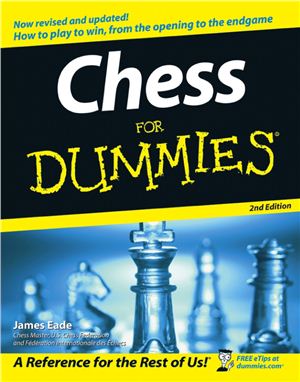Wiley Publishing, 2005.— xviii, 366
This book is designed to help you become a better chess player in several ways: First, it contains a great deal of information and advice on how to play chess. You can also find in these pages information about how to talk about chess, which, to many players, is at least as important as knowing how to play. (Part of the fun of chess is the social element involved in discussing other people’s games — called kibitzing.) Finally, the book offers numerous suggestions on how to find other players who are just about at your own level (and how to mind your chess manners when you sit down to play!). If you’re a beginner, the great joys of chess await you. If you’re an intermediate player, you can find in this book a wealth of material to help you improve your game and to enjoy chess even more.
ISBN 0-7645-8404-9
Laying the Groundwork
Tackling the Chess Basics
Greeting the Pieces and Their Powers
Getting to Know the Elements of Chess
Looking Out for the King: Check, Stalemate, and Checkmate
Gaining Chess Know-How
Tactics and Combinations in Hand-to-Hand Combat
Sacrifices: When It’s Better to Give than to Receive
Mastering Mating Pattes
Building Patte Recognition
Recognizing Pawn Formations
Making Special Moves
Game Time: Putting Your Chess Foot Forward
Selecting Your Strategy: The Principles of Play
Coming on Strong in the Opening
Making Headway during the Middlegame
Exiting with Style in the Endgame
Getting into Advanced Action
Competition Play and Necessary Etiquette
Hitting the Net with Computer Chess
Got Notation? Reading and Writing about Chess
The Part of Tens
The Ten Most Famous Chess Games
The Ten Best Players of All Time
Appendixes
A Glossary of Chess
Other Chess Resources
This book is designed to help you become a better chess player in several ways: First, it contains a great deal of information and advice on how to play chess. You can also find in these pages information about how to talk about chess, which, to many players, is at least as important as knowing how to play. (Part of the fun of chess is the social element involved in discussing other people’s games — called kibitzing.) Finally, the book offers numerous suggestions on how to find other players who are just about at your own level (and how to mind your chess manners when you sit down to play!). If you’re a beginner, the great joys of chess await you. If you’re an intermediate player, you can find in this book a wealth of material to help you improve your game and to enjoy chess even more.
ISBN 0-7645-8404-9
Laying the Groundwork
Tackling the Chess Basics
Greeting the Pieces and Their Powers
Getting to Know the Elements of Chess
Looking Out for the King: Check, Stalemate, and Checkmate
Gaining Chess Know-How
Tactics and Combinations in Hand-to-Hand Combat
Sacrifices: When It’s Better to Give than to Receive
Mastering Mating Pattes
Building Patte Recognition
Recognizing Pawn Formations
Making Special Moves
Game Time: Putting Your Chess Foot Forward
Selecting Your Strategy: The Principles of Play
Coming on Strong in the Opening
Making Headway during the Middlegame
Exiting with Style in the Endgame
Getting into Advanced Action
Competition Play and Necessary Etiquette
Hitting the Net with Computer Chess
Got Notation? Reading and Writing about Chess
The Part of Tens
The Ten Most Famous Chess Games
The Ten Best Players of All Time
Appendixes
A Glossary of Chess
Other Chess Resources

